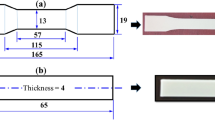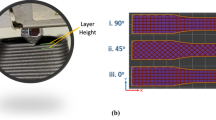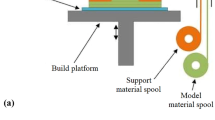Abstract
This study investigates and optimizes the tensile, flexural and compressive strengths of polymer parts for local and small industrial components. Extrusion-based additive manufacturing, i.e., fused deposition modeling (FDM) technology is used to manufacture the parts from acrylic butadiene styrene (ABS) material. The samples are produced according to selected process parameters such as road angle, filling percentage, layer size, printing temperature and printing speed, which are varied at three levels. The experiments are designed using a central composite design based on response surface methodology (RSM) in MINITAB software. Mechanical testing is performed using universal testing machines and data are collected for statistical analysis. In addition, hybrid approaches based on artificial intelligence are used for parameter optimization to achieve maximum tensile, bending and compressive strengths. Tensile and bending samples are also subjected to fracture mechanism investigation using scanning electron microscopy (SEM). The results show that the first technique, i.e., response surface methodology and genetic algorithm, resulted in an improvement in tensile, flexural and compressive strength by 2.5%, 7.58% and 8.86%, respectively, compared to the highest values of all experiments. The second approach, i.e., the genetic algorithm for artificial neural networks, provides the tensile, bending and compressive strengths with an improvement of 3.74%, 2.04% and 5.49%, respectively. Similarly, the third technique, adaptive neuro-fuzzy inference system genetic algorithm, yields 4.97%, 6.16%, and 2.62% improvement in tensile, flexural, and compressive strength, respectively. Overall, the results show that the hybrid optimization techniques can provide the desired mechanical strengths of FDM parts for selected applications. The optimized results are confirmed by experiments and scientific methods.
















Similar content being viewed by others
Data availability
The data that support the findings of this study are available from the corresponding author upon reasonable request.
Abbreviations
- RSM:
-
Response surface methodology
- ANFIS:
-
Adaptive neuro-fuzzy inference system
- ANN:
-
Artificial neural network
- GA:
-
Genetic algorithm
- TS/σt :
-
Tensile strength
- FS/σf :
-
Flexural strength
- CS/\({\upsigma }_{{\text{c}}}\) :
-
Compressive strength
- UTS:
-
Ultimate tensile strength
- IS:
-
Impact strength
- AG:
-
Air gap
- RA:
-
Raster angle
- RW:
-
Raster width
- NT:
-
Nozzle temperature
- LT:
-
Layer thickness
- FP:
-
Filling pattern
- BO:
-
Build orientation
- CN:
-
Contour number
- ID:
-
Infill density
- PHS:
-
Print head speed
- DOE:
-
Design of experiment
- FEA:
-
Finite element analysis
- CCD:
-
Central composite design
- ANOVA:
-
Analysis of variance
- FFF:
-
Fused filament fabrication
- FDM:
-
Fused deposition modeling
- AM:
-
Additive manufacturing
- ABS:
-
Acrylic butadiene styrene
- AI:
-
Artificial Intelligence
- FCCD:
-
Face central composite design
- CAD:
-
Computer aided design
- UTM:
-
Universal tensile machine
- ASTM:
-
American society for testing & materials
- CW:
-
Contour width
- S:
-
Speed
References
Naik M, Thakur DG (2021) Experimental investigation of effect of printing parameters on impact strength of the bio-inspired 3D printed specimen. Sadhana—Acad Proc. Eng Sci https://doi.org/10.1007/s12046-021-01671-8
Abas M, Al AM, Habib T, Noor S (2023) Analyzing surface roughness variations in material extrusion additive manufacturing of nylon carbon fiber composites. Polymers (Basel). https://doi.org/10.3390/polym15173633
Dev S, Srivastava R (2022) Influence of process variables on mechanical properties and material weight of acrylic butadiene styrene parts produced by fused filament fabrication. Prog Addit Manuf. https://doi.org/10.1007/s40964-022-00318-2
Yadav DK, Srivastava R, Dev S (2020) Design & fabrication of ABS part by FDM for automobile application. Mater Today Proc 26:2089–2093. https://doi.org/10.1016/j.matpr.2020.02.451
Vaezi M, Chua CK (2014) Effects of layer thickness and binder saturation level parameters on 3D printing process. Int J Adv Manuf Technol 53:275–284. https://doi.org/10.1007/s00170-010-2821-1
Farzadi A, Solati-hashjin M, Asadi-eydivand M et al (2014) Effect of layer thickness and printing orientation on mechanical properties and dimensional accuracy of 3D printed porous samples for bone tissue engineering. PLoS ONE 9:1–14. https://doi.org/10.1371/journal.pone.0108252
Lanzotti A, Grasso M, Staiano G, Martorelli M (2015) The impact of process parameters on mechanical properties of parts fabricated in pla with an open-source 3-D Printer. Rapid Prototyp J 21:604–617
Ning F (2016) Additive manufacturing of carbon fiber-reinforced plastic composites using fused deposition modeling: effects of effects of process parameters on tensile properties. J Compos Mater. https://doi.org/10.1177/0021998316646169
Lee BH, Abdullah J, Khan ZA (2005) Optimization of rapid prototyping parameters for production of flexible ABS object. J Mater Process Technol 169:54–61. https://doi.org/10.1016/j.jmatprotec.2005.02.259
Thomas JP, Thomas JP, Renaud JE (2003) Design of fused-deposition ABS components for stiffness. J Mech Des 125:545–551. https://doi.org/10.1115/1.1582499
Rodrı F, Thomas JP, Renaud JE (2003) materials modeling mechanical behavior of acrylonitrile butadiene styrene fused deposition materials modeling. Rapid Prototyp J 9:219–230. https://doi.org/10.1108/13552540310489604
Ulu E, Korkmaz E, Yay K et al (2015) Enhancing the structural performance of additively manufactured objects through build orientation optimization. J Mech Des 10(1115/1):4030998
Wu W, Geng P, Li G et al (2015) Influence of layer thickness and raster angle on the mechanical properties of 3D-printed PEEK and a comparative mechanical study between PEEK and ABS. Materials (Basel) 8:5834–5846. https://doi.org/10.3390/ma8095271
Liu J, Gaynor AT, Chen S et al (2018) Current and future trends in topology optimization for additive manufacturing. Struct Multidiscip Optim. https://doi.org/10.1007/s00158-018-1994-3
Ahn S, Wright PK (2002) Anisotropic material properties of fused deposition modeling ABS. Rapid Prototyp Journa 8:248–257. https://doi.org/10.1108/13552540210441166
Ang KC, Leong KF, Chua CK (2006) Investigation of the mechanical properties and porosity relationships in fused deposition modelling-fabricated porous structures. Rapid Prototyp J 12:100–105. https://doi.org/10.1108/13552540610652447
Chacón JM, Caminero MA, García-Plaza E, Núñez PJ (2017) Additive manufacturing of PLA structures using fused deposition modelling: Effect of process parameters on mechanical properties and their optimal selection. Mater Des 124:143–157. https://doi.org/10.1016/j.matdes.2017.03.065
Baikerikar PJ, Turner CJ (2017) Comparison of as-built FEA simulations and experimental results for additively manufactured dogbone geometries. Int. Des. Eng. Tech. Conferences Comput. Inform. Eng. Conference IDETC/CIE 2017:1–14
Farbman D, Mccoy C (2016) Materials testing of 3D printed ABS and PLA samples to guide mechanical MSEC2016–8668. In: International Manufacturing Science and Engineering Conference MSEC2016
Dev S, Srivastava R (2020) Experimental investigation and optimization of FDM process parameters for material and mechanical strength. Mater Today Proc 26:1995–1999. https://doi.org/10.1016/j.matpr.2020.02.435
Emmelmann C, Petersen M, Kranz J (2019) Bionic lightweight design by laser additive manufacturing (LAM) for aircraft industry. SPIE Eco-Photonics, Strasbourg, France
Griffiths CA, Howarth J, Rees A, Kerton R (2016) A design of experiments approach for the optimisation of energy and waste during the production of parts manufactured by 3D printing. J Clean Prod. https://doi.org/10.1016/j.jclepro.2016.07.182
Farbman D, Mccoy C (2017) Materials testing of 3D Printed ABS and PLA samples to guide mechanical MSEC2016–8668. https://doi.org/10.1115/MSEC2016-8668
Torrado AR, Roberson DA (2016) Failure analysis and anisotropy evaluation of 3D-printed tensile test specimens of different geometries and print raster patterns. J Fail Anal Prev 16:154–164. https://doi.org/10.1007/s11668-016-0067-4
Asadollahi-Yazdi E, Gardan J, Lafon P (2018) Toward integrated design of additive manufacturing through a process development model and multi-objective optimization. Int J Adv Manuf Technol 96:4145–4164. https://doi.org/10.1007/s00170-018-1880-6
Noraihan T, Tuan A, Abdullah AM, Akil H (2019) Recent developments in fused deposition modeling-based 3D printing of polymers and their composites. Polym Rev 59:589–624. https://doi.org/10.1080/15583724.2019.1597883
Giannakopoulos KI, Stergiou C (2018) Mechanical properties of 3D printed polymer specimens Thermo-mechanical modeling of a high pressure turbine blade of an airplane gas turbine. Procedia Struct Integr 10:85–90. https://doi.org/10.1016/j.prostr.2018.09.013
Dilberoglu UM, Simsek S, Yaman U et al (2019) (2019) Shrinkage compensation approach proposed for ABS material in FDM process. Mater Manuf Process. https://doi.org/10.1080/104269141594252
Zhou X, Hsieh S (2018) Ting C (2018) Modelling and estimation of tensile behaviour of polylactic acid parts manufactured by fused deposition modelling using finite element analysis and knowledge-based library. Virtual Phys Prototyp. https://doi.org/10.1080/174527591442681
Fernandez-vicente M (2016) Effect of infill parameters on tensile mechanical behavior in desktop 3D printing. 3D Print Addit Manuf 3:183–192. https://doi.org/10.1089/3dp.2015.0036
Lubombo C, Huneault M (2018) Effect of infill patterns on the mechanical performance of lightweight 3D-Printed Cellular PLA Parts. Mater Today Commun. https://doi.org/10.1016/j.mtcomm.2018.09.017
Clausen A, Aage N, Sigmund O (2016) Exploiting additive manufacturing infill in topology optimization for improved buckling load. Engineering 2:250–257. https://doi.org/10.1016/J.ENG.2016.02.006
Ahn S, Montero M, Odell D et al (2002) Anisotropic material properties of fused deposition modeling ABS. Rapid Prototyp J 8:248–257. https://doi.org/10.1108/13552540210441166
Zhang Y, Chou K (2008) A parametric study of part distortions in fused deposition modelling using three-dimensional finite element analysis. J Eng Manuf 222:959–967. https://doi.org/10.1243/09544054JEM990
Kumar A, Ohdar RK, Mahapatra SS (2010) Parametric appraisal of mechanical property of fused deposition modelling processed parts. Mater Des 31:287–295. https://doi.org/10.1016/j.matdes.2009.06.016
Masood SH, Mau K, Song WQ (2010) Tensile properties of processed FDM polycarbonate material. Mater Sci Forum 656:2556–2559. https://doi.org/10.4028/www.scientific.net/MSF.654-656.2556
Sood AK, Chaturvedi V, Datta S, Mahapatra SS (2011) Optimization of process parameters in fused deposition modeling using weighted principal component analysis. J Adv Manuf Syst 10:241–259. https://doi.org/10.1142/S0219686711002181
Sood AK (2011) Study on parametric optimization of fused deposition modelling (FDM) process. Thesis, Doctor of Philosophy.
Onwubolu GC, Rayegani F (2014) Characterization and optimization of mechanical properties of ABS parts manufactured by the fused deposition modelling process. Int J Manuf Eng. 2014:1–13
Rayegani F, Onwubolu GC (2014) Fused deposition modelling ( FDM ) process parameter prediction and optimization using group method for data handling (GMDH) and differential evolution (DE). Int J Adv ManufTechnol 73:509–519. https://doi.org/10.1007/s00170-014-5835-2
Nidagundi VB, Keshavamurthy R, Prakash CPS (2015) Studies on parametric optimization for fused deposition modelling process. Mater Today Proc 2:1691–1699. https://doi.org/10.1016/j.matpr.2015.07.097
Gebisa AW, Lemu HG (2018) Investigating effects of fused-deposition modeling (FDM) processing parameters on flexural properties of ULTEM 9085 using designed experiment. Materials (Basel) 11:1–23. https://doi.org/10.3390/ma11040500
Dong G, Wijaya G, Tang Y, Zhao YF (2018) Optimizing process parameters of fused deposition modeling by Taguchi method for the fabrication of lattice structures. Addit Manuf 19:62–72. https://doi.org/10.1016/j.addma.2017.11.004
Harris M, Potgieter J, Ray S, Archer R (2019) Preparation and characterization of thermally stable ABS / HDPE blend for fused filament fabrication. Mater Manuf Process 00:1–11. https://doi.org/10.1080/10426914.2019.1692355
Dakshinamurthy D, Gupta S (2016) A Study on the influence of process parameters on the viscoelastic properties of ABS components manufactured by FDM process. J Inst Eng Ser C 99:133–138. https://doi.org/10.1007/s40032-016-0324-z
Mohamed OA, Masood SH, Bhowmik JL (2015) Optimization of fused deposition modeling process parameters : a review of current research and future prospects. Adv Manuf 3:42–53. https://doi.org/10.1007/s40436-014-0097-7
Xinhua L, Shengpeng L, Zhou L et al (2015) An investigation on distortion of PLA thin-plate part in the FDM process. Int J Adv ManufTechnol. https://doi.org/10.1007/s00170-015-6893-9
Rayegani F, Onwubolu GC (2014) Fused deposition modelling (FDM) process parameter prediction and optimization using group method for data handling (gmdh) and differential evolution (de). Int J Adv Manuf Technol 73:509–519. https://doi.org/10.1007/s00170-014-5835-2
Tymrak BM, Kreiger M, Pearce JM (2014) Mechanical properties of components fabricated with open-source 3-D printers under realistic environmental conditions. Mater Des 58:242–246. https://doi.org/10.1016/j.matdes.2014.02.038
Rankouhi B, Javadpour S, Delfanian F, Letcher T (2017) Failure analysis and mechanical characterization of 3D printed ABS with respect to layer thickness and orientation. J Fail Anal Prev. https://doi.org/10.1007/s11668-016-0113-2
Sood AK, Ohdar RK, Mahapatra SS (2012) Experimental investigation and empirical modelling of FDM process for compressive strength improvement. J Adv Res 3:81–90. https://doi.org/10.1016/j.jare.2011.05.001
Correia DS, Gonçalves CV, Da Cunha SS, Ferraresi VA (2005) Comparison between genetic algorithms and response surface methodology in GMAW welding optimization. J Mater Process Technol 160:70–76. https://doi.org/10.1016/j.jmatprotec.2004.04.243
Srinivasan R, Pridhar T, Ramprasath LS et al (2020) Prediction of tensile strength in FDM printed ABS parts using response surface methodology (RSM). Mater Today Proc 27:1827–1832. https://doi.org/10.1016/j.matpr.2020.03.788
Dave HK, Patel BH, Rajpurohit SR et al (2021) Effect of multi-infill patterns on tensile behavior of FDM printed parts. J Brazilian Soc Mech Sci Eng 43:1–15. https://doi.org/10.1007/s40430-020-02742-3
D’Amico AA, Debaie A, Peterson AM (2017) Effect of layer thickness on irreversible thermal expansion and interlayer strength in fused deposition modeling. Rapid Prototyp J 23:943–953. https://doi.org/10.1108/RPJ-05-2016-0077
Chohan JS, Mittal N, Kumar R et al (2020) Mechanical strength enhancement of 3d printed acrylonitrile butadiene styrene polymer components using neural network optimization algorithm. Polymers (Basel) 12:1–18. https://doi.org/10.3390/polym12102250
Dev S, Srivastava R (2021) Parametric analysis and optimization of fused deposition modeling technique for dynamic mechanical properties of acrylic butadiene styrene parts. Proc Inst Mech Eng Part C J Mech Eng Sci. 236:4166
Yadav P, Dev S, Hussain I, Kumar R (2023) Evaluation of additive manufacturing process parameters for improved mechanical properties of thermoplastic parts. Mater Today Proc. https://doi.org/10.1016/j.matpr.2022.12.150
Garg A, Bhattacharya A, Batish A (2015) Failure investigation of fused deposition modelling parts fabricated at different raster angles under tensile and flexural loading. Proc IMechE Part B J Eng Manuf. https://doi.org/10.1177/0954405415617447
Volpato N, Zanotto TT (2019) Analysis of deposition sequence in tool-path optimization for low-cost material extrusion additive manufacturing. Int J Adv Manuf Technol 101:1855–1863. https://doi.org/10.1007/s00170-018-3108-1
Sood AK (2011) Study on parametric optimization of fused deposition modelling (FDM) process. Doctoral Dissertation. National Institute of Technology Rourkela. Available at: https://core.ac.uk/download/pdf/53188171.pdf
Yadav P, Sahai A, Sharma RS (2021) Flexural strength and surface profiling of carbon-based PLA parts by additive manufacturing. J Inst Eng Ser C 102:921–931. https://doi.org/10.1007/s40032-021-00719-2
Yadav P, Sahai A, Sharma RS (2021) Strength and surface characteristics of FDM-Based 3D printed PLA parts for multiple infill design patterns. J Inst Eng Ser C 102:197–207. https://doi.org/10.1007/s40032-020-00625-z
Abbas T, Othman FM, Ali HB (2017) Effect of infill parameter on compression property in FDM process. J Eng Res Appl 7:16–19. https://doi.org/10.9790/9622-0710021619
Abbas T, Othman FM, Ali HB (2017) Effect of infill Parameter on compression property in FDM Process Effect of infill Parameter on compression property in FDM Process. Int J Eng Res Appl 7:16–19. https://doi.org/10.9790/9622-0710021619
Nomani J, Wilson D, Paulino M, Mohammed MI (2020) Effect of layer thickness and cross-section geometry on the tensile and compression properties of 3D printed ABS. Mater Today Commun 22:100626. https://doi.org/10.1016/j.mtcomm.2019.100626
Nathaphan S, Trutassanawin W (2021) Effects of process parameters on compressive property of FDM with ABS. Rapid Prototyp J 27:905–917. https://doi.org/10.1108/RPJ-12-2019-0309
Nomani J, Wilson D, Paulino M, Mohammed MI (2020) Effect of layer thickness and cross-section geometry on the tensile and compression properties of 3D printed ABS. Mater Today Commun 22:100626
Abdullah AM, Mohamad D, Rahim TNAT et al (2019) Effect of narrow infill density gap on the compressive properties of 3D printed carbon fibre reinforced acrylonitrile butadiene styrene. J Mech Sci Technol 33:2339–2343. https://doi.org/10.1007/s12206-019-0433-8
Popović M, Pjević M, Milovanović A et al (2023) Printing parameter optimization of PLA material concerning geometrical accuracy and tensile properties relative to FDM process productivity. J Mech Sci Technol 37:697–706. https://doi.org/10.1007/s12206-023-0113-6
Khan I, Tariq M, Abas M et al (2023) Parametric investigation and optimisation of mechanical properties of thick tri-material based composite of PLA-PETG-ABS 3D-printed using fused filament fabrication. Compos Part C Open Access. https://doi.org/10.1016/j.jcomc.2023.100392
Acknowledgements
We are grateful to the Director MNNIT Allahabad, Prayagraj, Uttar Pradesh, India, for providing necessary laboratory facilities.
Funding
This research did not obtain any grant from funding agencies in the commercial, public, or not-for-profit divisions.
Author information
Authors and Affiliations
Contributions
Rajeev Srivastava: designed the study and guided to perform experiments; Saty Dev: performed the experiments, analyzed the results, writing—original draft preparation. All authors read and commented on the manuscript.
Corresponding author
Ethics declarations
Conflict of interests
The authors declare that they have no conflict of interest.
Additional information
Publisher's Note
Springer Nature remains neutral with regard to jurisdictional claims in published maps and institutional affiliations.
Rights and permissions
Springer Nature or its licensor (e.g. a society or other partner) holds exclusive rights to this article under a publishing agreement with the author(s) or other rightsholder(s); author self-archiving of the accepted manuscript version of this article is solely governed by the terms of such publishing agreement and applicable law.
About this article
Cite this article
Dev, S., Srivastava, R. Experimental investigation and optimization of the additive manufacturing process through AI-based hybrid statistical approaches. Prog Addit Manuf (2024). https://doi.org/10.1007/s40964-024-00606-z
Received:
Accepted:
Published:
DOI: https://doi.org/10.1007/s40964-024-00606-z




